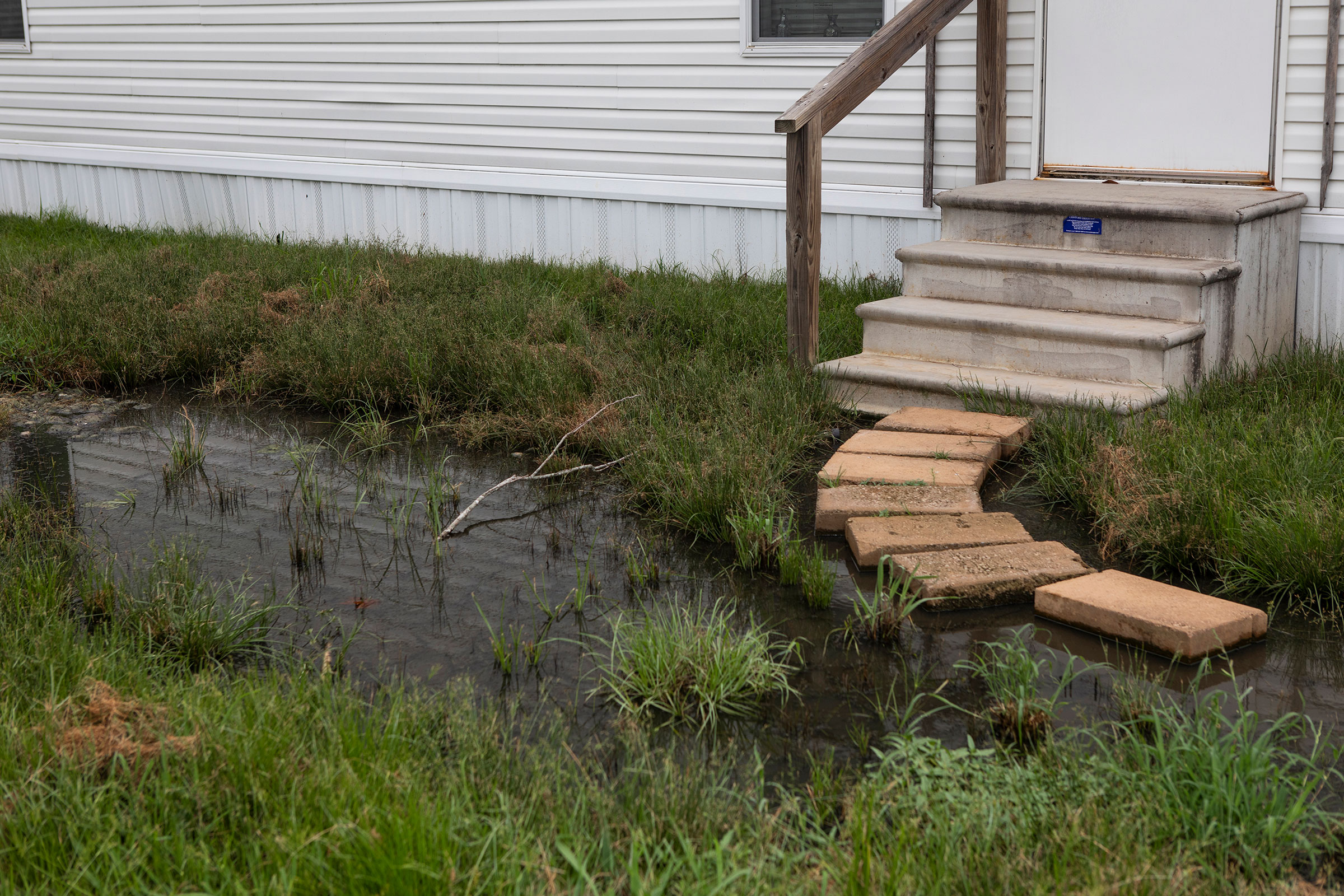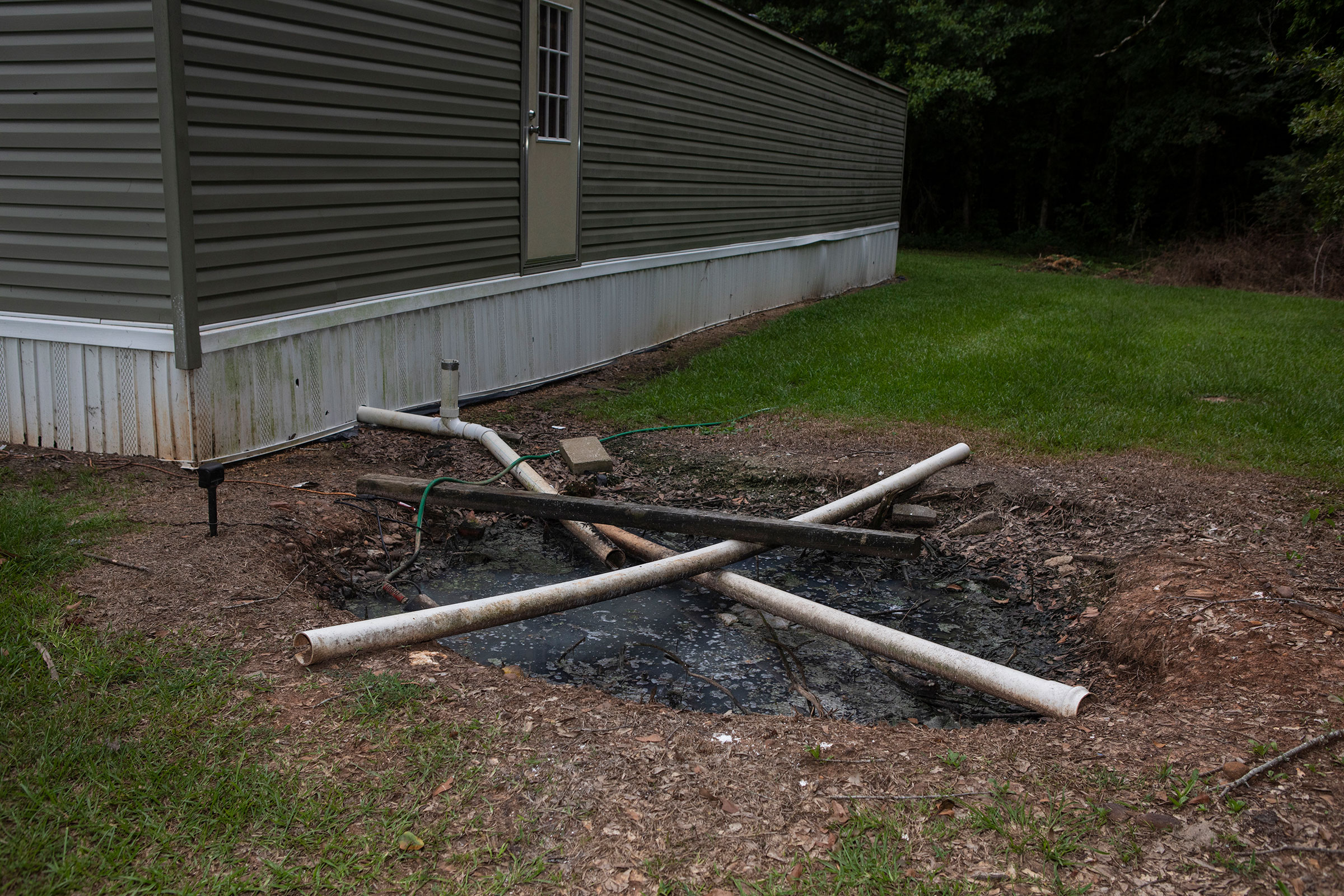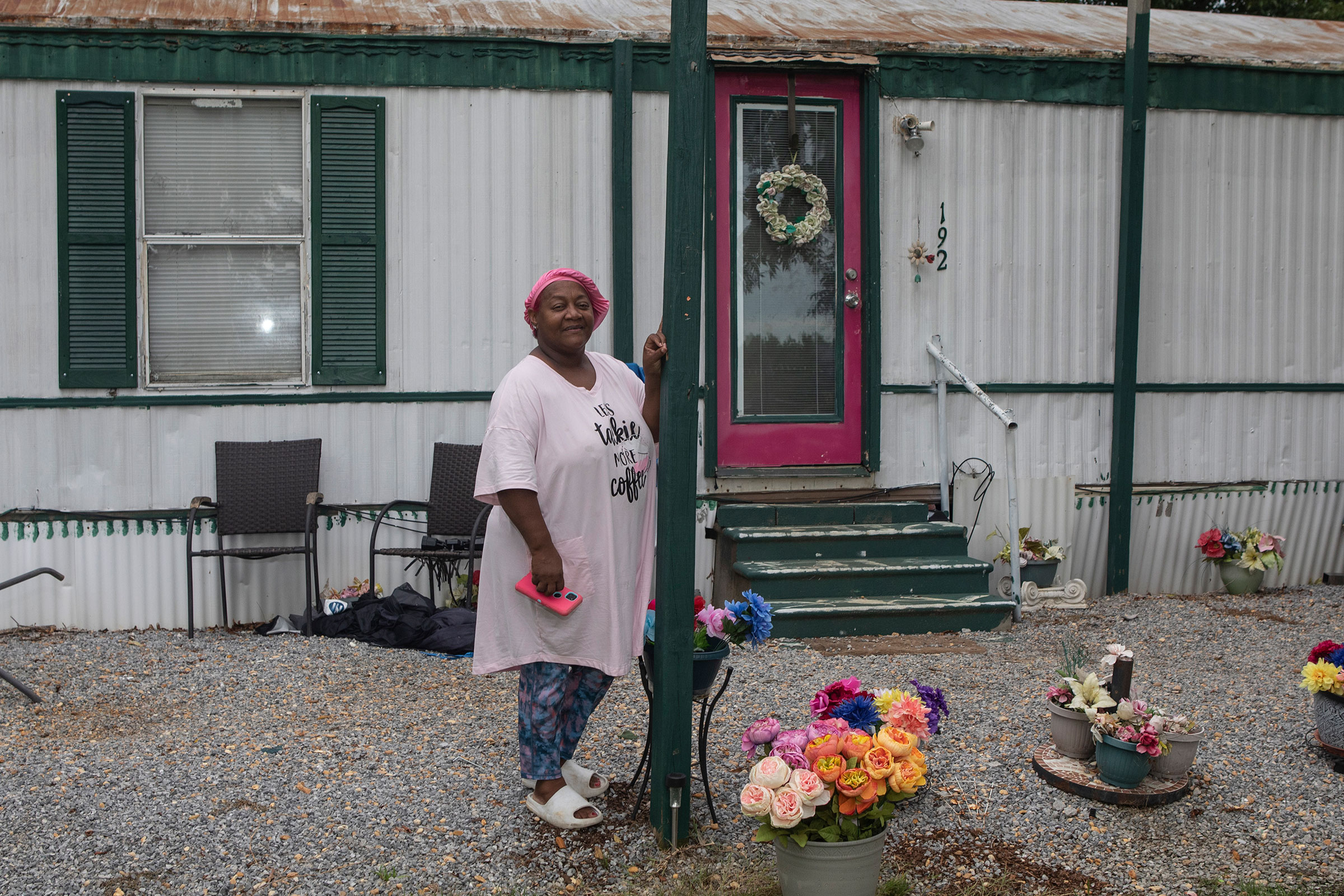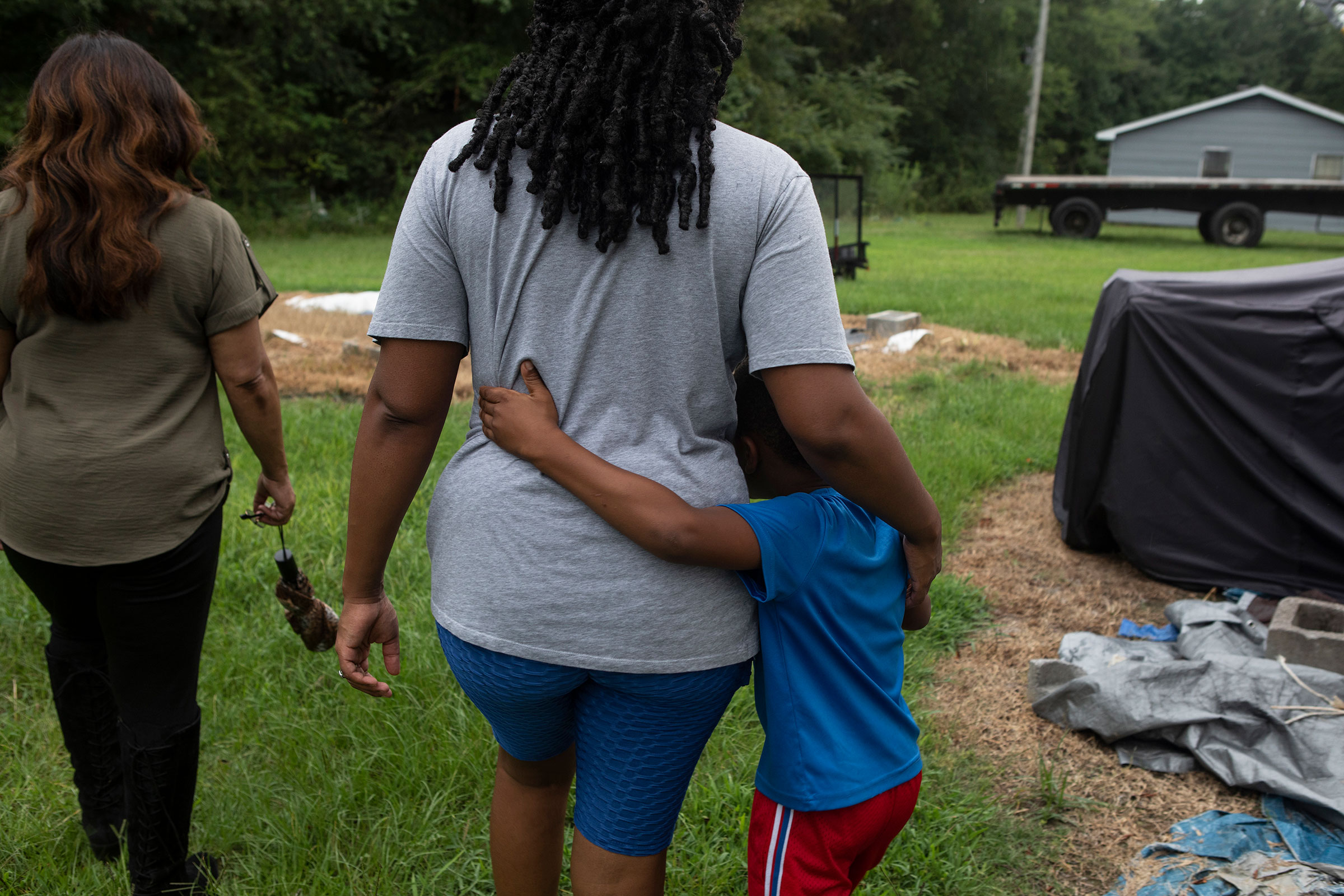
On this remote Alabama highway nearly 60 years ago, thousands of activists marched from Selma to Montgomery to demand that the state stop blocking Black Americans’ right to vote. The clash that followed—peaceful protesters confronted by uniformed police wielding clubs and tear gas—helped catalyze federal voting rights legislation.
Many of the families here in Lowndes County housed the marchers and joined in the cause. Annye Burke, who lives just off the highway, remembers how her family aided activists throughout those tumultuous years. “When they came through,” says Burke, 55, “we just participated.”
Today, a different civil rights issue threatens residents of Lowndes County and exposes the persistent inequality in how the U.S. government protects the environment its citizens depend on. More than 40% of this majority-black county lacks access to clean sanitation. The dire circumstances have led to health problems including hookworm, a disease once thought eradicated from the U.S. The clubs and tear gas may be gone, but the socioeconomic and political challenges rooted in centuries of systemic oppression keep bubbling up.
Burke lives next to her daughter Mautreé Burke-Clarke, and when I visited that home a few weeks ago along with government officials from Washington, Burke’s grandson Malachi, 4, was running around outside, paying little attention to the history lesson. Instead, he wanted to know what had happened to the turtles that often bask in the puddle in the backyard. His grandmother demurred and offered him a warning instead: stay away from that water.
What she didn’t tell him was that the puddle is a noxious mixture of precipitation and sewage that had leaked out of their faulty septic tank. They tried to mask the hole in the ground with a gray tarp, but the green broth had overwhelmed that temporary solution and left them to live with the myriad hazards that accompany exposed human waste within feet of their home.

More from TIME
Lowndes County has become emblematic of the sanitation problems plaguing an untold number of Americans nationwide. Reports have estimated that 2 million people lack access to clean water in the U.S., though no comprehensive survey has been conducted, and Black Americans are nearly twice as likely as their white counterparts to lack access to an adequate plumbing and sanitation system, according to a 2019 report from the U.S. Water Alliance.
But things might finally be changing in Lowndes. The politicians who visited Burke-Clarke’s house in early August—including Environmental Protection Agency (EPA) Administrator Michael Regan—weren’t on a fact-finding mission or there to spread awareness. Instead, they came to Lowndes with money and a plan. Their goal, they said, was to rid the region—and others like it across the country—of this fetid problem not just by throwing money at the state, but also by providing dedicated expertise and a vigilant attitude that would see the transformation through to the end. “We have an historic opportunity,” Regan told a crowd in Lowndes on Aug. 2. “EPA has $50 billion—billion with a ‘b’—to focus on wastewater issues in this country. It’s high time that communities like Lowndes County get their fair share.”
But, even with available money, actually making a change in places like Lowndes is easier said than done. The nation’s thorniest environmental justice problems are deeply intertwined with the same resilient system of oppression that kept Black Americans first enslaved and later away from the ballot box and at separate lunch counters. Poor people of color are a voting bloc that rarely commands much political power. And, even when they do get the attention of national officials, federal authorities depend on the work of state and local authorities to distribute money—a difficult proposition given the local resistance to racial justice measures in many state capitols and the lingering endemic poverty in many majority-Black municipalities. The Administration’s new initiative seems to recognize that providing meaningful help for the nation’s sanitation crisis requires digging down to the roots of the problem and acknowledging that the federal government will not succeed by writing a check and looking away.
Residents are cautiously optimistic, but have learned to be wary of the government throwing money at a problem encumbered by the weight of centuries of systemized discrimination and neglect. “Black and white is still a factor,” Mary McDonald, a long time Lowndes resident, told me on her front porch. “Always has been. Always will be.”

An insidious problem
The sanitation problem in this part of Alabama is so insidious that it’s easy to imagine a visitor coming away with a myopic sense that the county has overcome its history of oppression. The Lowndes Interpretive Center, located just off the highway, celebrates the role activism in Lowndes played in dismantling Jim Crow laws. Next to the Edmund Pettus Bridge, the site where police beat voting rights marchers in 1965, is a quaint museum that celebrates the victories of the Civil Rights Movement. And while the Confederate flag can be a common sight elsewhere in the state, I didn’t spot a single one in Lowndes.
But with a peek behind a house, a drive down a side street, or an extended conversation with a local, the persistent problem comes into view. There’s the cesspool behind Burke-Clarke’s home. Twenty minutes away, just feet behind the houses on Pine Street, is a large exposed lagoon where sewage drains, covered in a coat of green slime. Down the road, puddles of waste have gathered in the grass between a cluster of mobile homes. A few slabs of concrete offer a path to the doorway of one trailer through the inches of sewage.
Residents can face prosecution for lacking adequate sanitation—local authorities in effect penalizing their poverty. For that reason they can be reluctant to share their problems with outsiders. Those who did speak with me would often note that the repairman was coming soon. But mounds of research show the problem is pervasive, and individual requests to repairmen will not be enough to fix it. I asked Gladys Grant, a longtime Lowndes resident who helped conduct a recent survey of county residents on sewage, about her sense of the problem. She replied with a sigh followed by a laugh. “Don’t nobody have septic tanks,” she said. “Mostly, everybody straight pipes.”
That’s the lingo for homes that have a PVC pipe that extends straight from the house into the backyard, creating a pungent puddle of sewage a few feet away. Others do have septic systems, whereby household waste drains from the house to a big tank underground that is periodically emptied by professionals. In theory septic systems should be better than straight pipes, but many of the residents like Burke-Clarke have faulty systems that are unfit for the particular soil and climatic conditions in the region. These broken septic systems create giant puddles of their own, and when it rains, the waste backs up into residents’ sinks and showers.

According to 2017 report from local universities, a study of homes not connected to the public sewer system in nearby Bibb County found that 35% had a failed septic system and another 15% straight piped. In neighboring Wilcox County, 60% of homes inspected straight piped. A separate 2017 study in Lowndes found that 42% of respondents had raw sewage on site.
Catherine Flowers founded the Center for Rural Enterprise and Environmental Justice to address the slew of social justice challenges in Lowndes, but her more than two decades of efforts to address rural sanitation issues show why there are no quick fixes. “We were never going to get to a solution until we first acknowledged that there was a problem,” she says.
Her persistence made Lowndes the most visible symbol of the national problem. She brought prominent figures to visit the county, from Bernie Sanders to Jane Fonda to a United Nations official who called the site “shocking.” I first wrote about Lowndes in TIME more than two years ago in a story about the country’s water issues. Early on, Flowers persuaded the Alabama congressional delegation to lead a push for federal appropriations in the 2002 federal budget that would be disbursed via the EPA to address the county’s sanitation issue. And, while she waited for the money to come, she found private benefactors who would help provide sanitation systems to some families most in need.

But those efforts failed to eradicate the problem. The private funding was limited in scale, and the federal dollars took eight years to disburse—even then the federal government only released it to fund research. Last year, funding the U.S. Department of Agriculture provided to the state to address the sanitation problem was returned after a series of bureaucratic mishaps at the local level. In short, the local government, with a limited tax base, has lacked the institutional capacity and matching funds to take advantage of federal dollars. Meanwhile, many residents I spoke to questioned whether the state government, run by conservative Republicans resistant to federal intervention, has wanted to help at all.
Any approach that will bring lasting change in Lowndes would need to grapple with all these issues and offer a systemic solution. “We have to change the process,” says Flowers. “We have to change the paradigm.”

‘Help is on the way’
To announce new help for Lowndes, three senior Biden Administration officials traveled there and delivered the message sitting a few feet behind a hole filled with raw sewage.
The substance of the Aug. 2 announcement from the heads of the EPA and U.S. Department of Agriculture as well as Biden’s infrastructure czar was, at least on the surface, as unglamorous as the site. The officials presented a multi-part plan for Lowndes and 10 other similarly challenged areas across the U.S. First, the federal government would provide assistance studying the county’s wastewater issue, looking at both the technical issues and financial barriers to providing sanitation in the region. Then, those same experts would develop a comprehensive plan and figure out how to fund it, including through the $1 trillion bipartisan infrastructure law that passed Congress last year. Finally, the federal government would maintain a sustained dialogue with state and county officials as well as other stakeholders on the ground to ensure officials follow through.
The melange of assessments, plans, and capacity building may sound too bureaucratic and indefinite to provide immediate relief for residents. But Regan argues that in launching this initiative the federal government is forcing the hand of state and local institutions. “We are creating a scenario where there are absolutely no excuses,” Regan says. “At the end of the day, if a state doesn’t want to cooperate, I don’t have to give the state the money.”
Flowers believes the announcement is the most significant delivery of resources in her two decades working on the rural sanitation issue in Lowndes. And she hopes it will offer a model that might help deal with thorny sanitation issues elsewhere. “This is a signal to other rural communities dealing with these kinds of issues,” she says. “Help is on the way.”

While the government’s push in Lowndes focuses on sanitation, it also hints at how authorities may be able to tackle a range of issues tied to systemic injustice, from the remediation of toxic industrial sites to the removal of lead pipes. Both the infrastructure law and the Inflation Reduction Act provide the Administration with tens of billions of dollars in funding to address issues related to environmental justice. And while activists argue those measures don’t go far enough, it presents a once-in-a-generation opportunity to right some of these wrongs.
Leaving Lowndes, I reflected on my conversation with McDonald. We sipped sweet tea on her porch as she recounted her experience living in the county over the last 60 years, and all its fits and starts towards a more equal future. She talked about how even after the passage of the country’s landmark civil rights laws in the 1960s, local officials prioritized institutions serving white residents over Black ones. She talked about the town’s sewage system, which was installed after the end of the Jim Crow to modernize the community, but still in a decade when segregationist George Wallace served as the state’s governor. “If the structure is messed up,” she said, ”you got to go back to the structure and get it straight.”
More Must-Reads from TIME
- Donald Trump Is TIME's 2024 Person of the Year
- Why We Chose Trump as Person of the Year
- Is Intermittent Fasting Good or Bad for You?
- The 100 Must-Read Books of 2024
- The 20 Best Christmas TV Episodes
- Column: If Optimism Feels Ridiculous Now, Try Hope
- The Future of Climate Action Is Trade Policy
- Merle Bombardieri Is Helping People Make the Baby Decision
Write to Justin Worland/Hayneville, Ala. at justin.worland@time.com